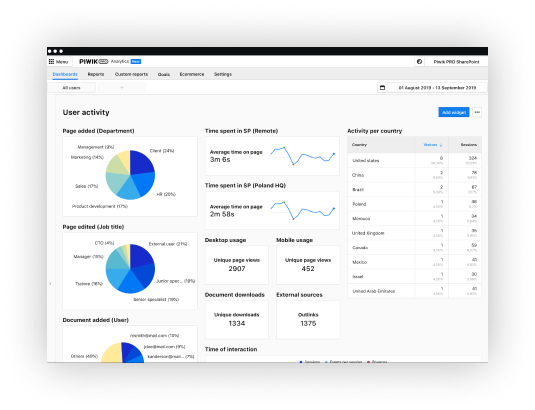Blog
Marketing analytics strategies to boost ROI

Marketing analytics strategies to boost ROI
The Return of Investment (ROI) is a measure to evaluate the performance of an organization which is the amount of return for an investment. As every organization plans to invest in resources for their future growth, measuring the return gives an idea of the profitability of the investment. In this article, we will get to know how marketing analytics is helping in the growth of businesses in terms of the ROI.

Marketing ROI
With the generation of back-to-back data, the inflow has to be effectively managed and stored. It is always crucial to uncover the hidden facts within the marketing analytics data. The interpretation showcases the various opportunities for the products or services. Further, this practice of measuring is what marketing analytics defines. And if you are thinking, what is the eventual goal of this practice? Well, it's the ROI.
Several ways exist to determine how effective a marketing campaign would be. They all go through the same pattern that includes gathering data, organizing the data, analyzing the data applying analytic techniques, and finally taking action on the findings.
A survey reported that only 21% of the marketers have tried analyzing their market strategies, while 79% of marketers have shown a blind eye towards this. They have missed their chances of wise expenses and somehow might have affected their business. The advantage of marketing analytics is also not utilized by every marketer.
So why is it always that important to consider marketing analytics? The only reason for this is that marketing analytics is the tried and tested way towards achieving effective marketing. It allows the marketer to evaluate their marketing campaigns and predict the audience responses.
The Best way of marketing analytics
1. Data collection: Two rules need to be followed by every analyst while collecting data. They are: focus on real-time data and maintain a high quality of the collected data. Real-time data gives real insights into the content allowing the quick settling of mistakes made in a day. High-quality data, on the other hand, is maintained if the source is genuine. 30% of the data (dirty) is erroneous. Therefore, we won't be considering it in the analytics study.
The process, therefore, allows effective tracking of the campaigns with an increase in sales opportunities.
2. Data analytics tools: Tools are the essential part of any analysis. It includes the data visualization tools and marketing analytics platform. Several online marketing tools are available for better visualization of the metrics. Best visualization tools always provide the data points more acceptably. Easy comparisons between data points can be possible through visualization.
3. AI-driven data analytics: Advent of technology has made the best use of AI. A report states that, in the world, 1.7MB data-per-second will be generated for every person. With AI at the forefront, the processing time of data reduces. With further improvement in the AI models, data analytics has seen a new future. Advanced machine learning methods help in streamlining the campaigning processes for predictive analysis. This high-powered software is well developed enough to make an effective decision. Advanced AIs implemented in business through the following ways:
-
Perform automated tasks like updating records, data transferring, etc.
-
AI models help in predicting customer behaviour and preferences through assessing customer information.
-
Queries of the customers are automatically answered even after business hours.
-
AIs provide an approach for simple content creation like hotel details and descriptions, business reports, etc.
-
Effective churn prediction predicts which customers used the product for a shorter term and who used it for a long term.
Increasing ROI with marketing analytics
The contribution of the marketing department is still a vast area to understand. There is still a lot more to know how marketing is affecting the growth of an organization. It's the executive head who is always held responsible. However, in the wake of the data revolution, the analytics approach has proven itself in measuring the impact of marketing efforts on revenue.
Maximizing the ROI seems to be a complicated task despite the development of several analytical tools. Several analysts and researchers have compiled some best practices and information that might help the marketers in boosting up their ROI
1. Planning ROI
It is the dream of every business or organization to achieve the desired aim. But, to achieve those, all the marketing activities need to be measured along with the desired results. Therefore, marketing campaigns are planned to keep in view the business goals. While setting up the goals, one must consider the following:
-
Goals should be specific instead of something vague.
-
It should be measurable and hence the proper data collection procedure and reporting methods.
-
It should be realistic enough to achieve them. Just being ambitious is not enough to achieve the goals.
-
Most important is that the goals for improving ROI should be relevant to the business goals.
-
Set up a timeframe within which the organization should achieve the goal. Time-bound goals provide motivation.
2. Always aware of the right metrics
An enormous amount of data is available on different channels of which only a required proportion is for analytics. You should be conscious of the data and consider all the metrics that align with the business plan or goals. Marketers often get involved with metrics that are not helpful in any way. Therefore only those metrics which will help in predicting the financial outcomes should be considered.
Below are the key metrics of marketing analysis
-
Analytics does not often mean data. It means deriving valuable information through such data. With tons of data generated every year, most of it remains unstructured. A whole process lies in transforming the unstructured data into meaningful insights. Therefore, one of the aspects of marketing analytics is the transformation of data into business-critical information.
-
It is always crucial to integrate the data with pre-existing knowledge to gain information on which data to formulate actions. Unless and until the data gets transformed into concepts, decisions are difficult to make. Conceptualization of the data is through data visualization through the display of numbers.
-
Customer experience is the driving force for every data collection process. Only with knowledge of what customer experiences can data be collected further for a timely decision-making process.
-
A constant analytics program is unable to provide much greater insight. Therefore to keep on analyzing the real-time data, continuous monitoring is required to sharply increase the output of the marketing campaigns to achieve improved results. One such tool that gives real-time marketing analytics is "Stately", which provides the tracking of customers to understand customer behaviour.
3. The ultimate focus: increase in sales
The digital world has made every customer research through the buying product. They explore every review of the products and ask for recommendations. Thus every click of the customer is adding information of the buyer over the database. When this information is the key focus, the company will provide more relevant information to the next visitors. It eventually will make them the customers.
4. Clarity on business value
Revenue is related to almost all the departments of an organization. However, the most impact on business value is by the marketing department.
5. Frequent experimentation
Campaigning results in predicting the future outcomes of an organization. Through various campaigns, a company will know the best strategy that will increase the ROI of the business. These experiments need to be complex; however, simple business experiments considering an action and target group will work. Therefore, it is always advisable to do experiments that will enhance the growth.
6. Monitoring the campaign performance
Assessing the performance of every campaign plays a part in getting an insight into which strategies are most effective. Campaign managers often find it easy while monitoring online advertising, as they can review the process in real-time. The metrics include clicks, conversions, etc. Therefore real-time monitoring is becoming a powerful tool in marketing analytics. Also, the integration of online applications with various channels might be helpful.
7. Forecasting
One factor that drives the marketing sector is timely information. Historical data is always crucial for marketers to predict future trends. Forecasting models will be beneficial as they can make the marketers understand how the campaign governs the product. Changes to a campaign will affect the future trends and demands of a product. By getting the insights promptly on time, the companies have an advantage over the competition.
8. Decision making
The ultimate growth of a business lies in the decision-making process. The team should be able to decide without having any regrets. All marketing strategies do not end up with positive results. Therefore, you must be quick in refining those strategies to start once again.
9. Marketing analytics tools
Analysis tools are crucial for marketing analytics as they are the basis behind every prediction carried out. Tools like Call Logic and LMS SYNC are used to understand the customer's needs while interacting with the organization. The call tracking platform optimizes the marketing campaigns providing detailed insights into the behaviour of the caller. Therefore it might boost up the existing sales of the company improving the marketing ROI.
Conclusion
Marketing analytics provides solutions for the future growth of every business. We have already found how marketing analysts boost up the ROI of a company. Simply tracking the metrics ain't help but only through proper analysis of the metrics. As we have seen, it is not always the numbers that matter but a lot more to it. The metrics might act as a step towards exploring what's going inside a business. It's only through these numbers that will decide the future growth. Further, the data being real-time, the ROI performance is boosted up. Real-time analytics is indeed a vital element in effective performance tracking and improving the ROI.